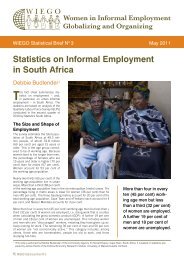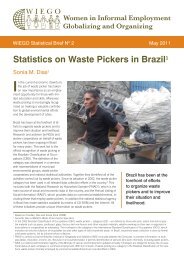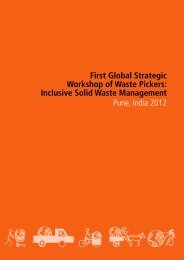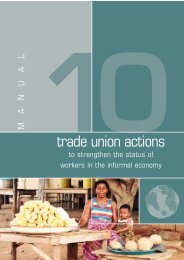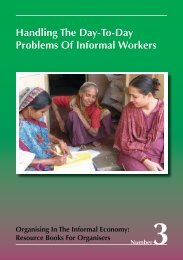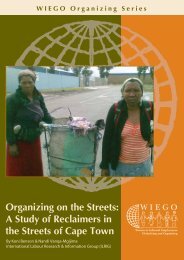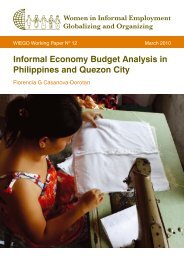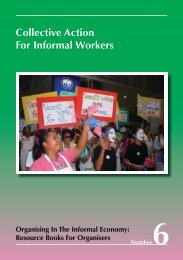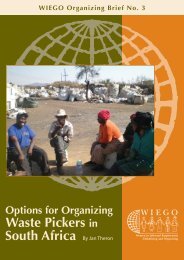The Informal Economy: Definitions, Theories and ... - Inclusive Cities
The Informal Economy: Definitions, Theories and ... - Inclusive Cities
The Informal Economy: Definitions, Theories and ... - Inclusive Cities
Create successful ePaper yourself
Turn your PDF publications into a flip-book with our unique Google optimized e-Paper software.
WIEGO Working Paper N o 1<br />
ganized into small-scale, decentralized, <strong>and</strong> more flexible economic units. Mass production was giving way<br />
to “flexible specialization” or, in some contexts, reverting to sweatshop production (Piore <strong>and</strong> Sabel 1984).<br />
<strong>The</strong>se changes were (<strong>and</strong> are still) associated with the informalization of employment relations. St<strong>and</strong>ard jobs<br />
were being turned into non-st<strong>and</strong>ard or atypical jobs with hourly wages but few benefits, or into piece-rate<br />
jobs with no benefits; production of goods <strong>and</strong> services was being subcontracted to small-scale informal units<br />
<strong>and</strong> industrial outworkers. In the process, the informal economy had become a permanent, but subordinate<br />
<strong>and</strong> dependent, feature of capitalist development (Portes, Castells <strong>and</strong> Benton 1989).<br />
Meanwhile, the economic crisis in Latin America in the 1980s highlighted another feature of the informal<br />
sector: namely, that employment in the informal sector instead of—or alongside—open unemployment,<br />
increases in many countries during periods of economic crisis (Tokman 1984). During the Asian economic<br />
crisis of the 1990s, millions of people who lost formal jobs in the former East Asian Tiger countries tried to<br />
find jobs or create work in the informal economy (Lee 1998). Meanwhile, structural adjustment in Africa<br />
<strong>and</strong> economic transition in the former Soviet Union <strong>and</strong> in Central <strong>and</strong> Eastern Europe were also associated<br />
with an expansion of employment in the informal economy.<br />
Why does employment in the informal economy often exp<strong>and</strong> during periods of economic adjustment or<br />
transition When enterprises are downsized or shut down, the workers who are laid-off <strong>and</strong> cannot find<br />
alternative formal jobs often end up working in the informal economy. This is particularly true of those who<br />
cannot afford to be unemployed, more so in countries without unemployment insurance or compensation.<br />
If hard economic times are accompanied by rising inflation or cutbacks in public services, households<br />
often need to supplement formal sector incomes with informal earnings.<br />
During the 1990s, globalization of the economy contributed to the informalization of the workforce in many<br />
industries <strong>and</strong> countries (St<strong>and</strong>ing 1999). Whereas globalization can generate new jobs <strong>and</strong> open new<br />
markets, many of the jobs are not “good” jobs <strong>and</strong> many of the new markets are inaccessible to small-scale<br />
or disadvantaged producers. This is because, in response to global competition, formal firms tend to hire all<br />
but a few core workers under informal arrangements or to outsource the production of goods <strong>and</strong> services<br />
to other firms <strong>and</strong> countries (Rodrik 1997). Further, informal firms <strong>and</strong> small producers often lack the market<br />
knowledge <strong>and</strong> skills to compete with formal firms for export markets <strong>and</strong> often face competition from<br />
imported goods in domestic markets.<br />
At present, there is renewed interest in the informal economy worldwide. In part, this is because the<br />
informal economy has grown worldwide <strong>and</strong> also emerged in new guises <strong>and</strong> in unexpected places. In<br />
part, this stems from the fact that informal employment exp<strong>and</strong>ed significantly during the recent great<br />
recession (Horn 2009). Today, informal employment is more than half of non-agricultural employment<br />
in most developed regions <strong>and</strong> as high as 82 per cent of non-agricultural employment in South Asia<br />
(Vanek et al. 2012). If data on informal employment in agriculture were included in these estimates,<br />
the proportion of informal employment in total employment would be even higher in heavily agricultural<br />
regions, especially in sub-Saharan Africa <strong>and</strong> more so in South Asia.<br />
This renewed interest also stems from the recognition of the links between informality <strong>and</strong> growth on<br />
the one h<strong>and</strong> <strong>and</strong> the links between informality, poverty, <strong>and</strong> inequality on the other. <strong>The</strong>re is increased<br />
recognition that much of the informal economy today is integrally linked to the formal economy <strong>and</strong><br />
contributes to the overall economy; <strong>and</strong> that supporting the working poor in the informal economy is a<br />
key pathway to reducing poverty <strong>and</strong> inequality. And there is increased recognition that women tend to<br />
be concentrated in the more precarious forms of informal employment, so that supporting working poor<br />
women in the informal economy is a key pathway to reducing women’s poverty <strong>and</strong> gender inequality<br />
(Chen et al. 2004, 2005).<br />
In sum, although interest in the informal economy has waxed <strong>and</strong> waned since the early 1970s, the concept<br />
has continued to prove useful to many policymakers, activists <strong>and</strong> researchers. This is because of the<br />
3




